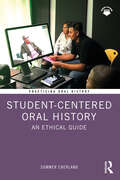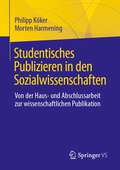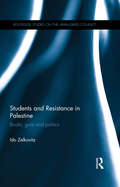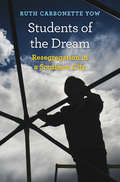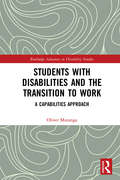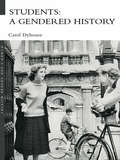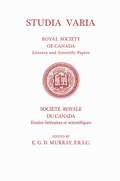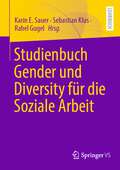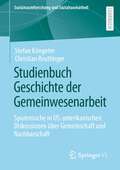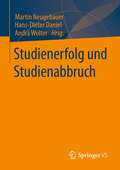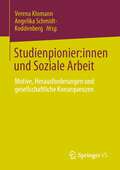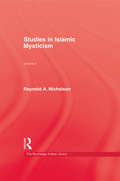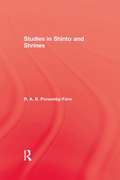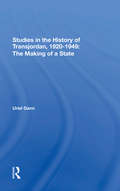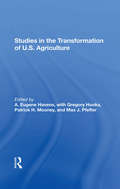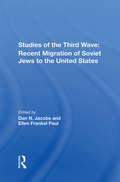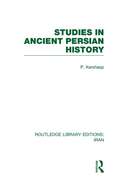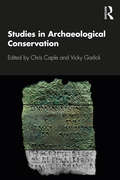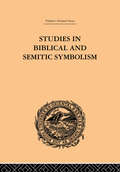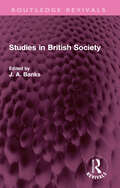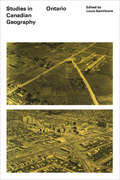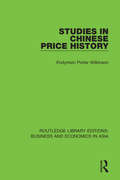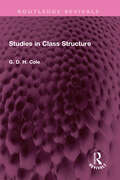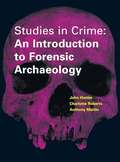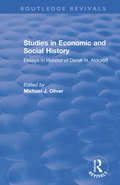- Table View
- List View
Student-Centered Oral History: An Ethical Guide (Practicing Oral History)
by Summer CherlandStudent-Centered Oral History explores the overlaps of culturally relevant teaching, student-centered teaching, and oral history to demonstrate how this method empowers students, especially those from historically underrepresented communities. With tangible tools like lesson plans and reflection sheets, available to download as eResources from the book's website, each interactive chapter is applicable to classrooms and age groups across the globe. Educators from all levels of experience will benefit from step-by-step guides and lesson plans, all organized around guiding questions. These lessons coach students and educators from start to finish through a student-centered oral history. Background research, historical context, cultivating a culture of consent, analysis, promotion, and gratitude are among the many lessons taught beyond writing questions and interviewing. With a specific focus on the ethics influencing a teacher’s role as guide and grader of a student-centered oral history, this book also highlights successful approaches across the world of students and teachers discovering oral history. These examples reveal how student-centered oral history empowers academic achievement, radicalizes knowledge, develops relationships, and promotes community engagement. This book is a useful tool for any students and scholars interested in oral history in an educational setting.
Studentisches Publizieren in den Sozialwissenschaften: Von der Haus- und Abschlussarbeit zur wissenschaftlichen Publikation
by Philipp Köker Morten HarmeningBisher fehlt es an Lehrbüchern, die sich spezifisch mit den Herausforderungen und Chancen des studentischen Publizierens befassen. Der Band will diese Lücke schließen und bietet eine systematische Einführung in den wissenschaftlichen Publikationsprozess aus studentischer Sicht und erläutert den Weg von der Haus- und Abschlussarbeit zur eigenen wissenschaftlichen Publikation. Grundsätzliche Unterschiede zwischen studentischen Qualifikationsarbeiten und wissenschaftlichen Aufsätzen werden ebenso behandelt wie unterschiedliche Publikationsformate, Peer-Review und die Gefahren von Raubverlagen. Weiterhin bietet es eine Schritt-für-Schritt Anleitung für den Weg von der ersten Idee bis zur publizierten Arbeit. Durch zahlreiche Beispiele, Check-Listen und weitere Ressourcen eignet sich das Buch nicht nur für Studierende, die ihre Arbeiten veröffentlichen oder mehr über den wissenschaftlichen Publikationsprozess lernen möchten, sondern auch für Dozierende als Ressource zur Nutzung in Lehrforschungsseminaren und -projekten.
Students and Resistance in Palestine: Books, Guns and Politics (Routledge Studies on the Arab-Israeli Conflict)
by Ido ZelkovitzExploring the Palestinian Student Movement from an historical and sociological perspective, this book demonstrates how Palestinian national identity has been built in the absence of national institutions, whilst emphasizing the role of higher education as an agent of social change, capable of crystallizing patterns of national identity. Focussing on the political and social activities of Palestinian students in two arenas – the West Bank and Gaza Strip, and the Palestinian diaspora, Students & Resistance covers the period from 1952-2000. The book investigates the commonality of the goal of the respective movements in securing independence and the building of a sovereign Palestinian state, whilst simultaneously comparing their development, social tone and the differing challenges each movement faced. Examining a plethora of sources including; Palestinian student magazines, PLO documents, Palestinian and Arabic news media, and archival records, to demonstrate how the Palestinian Student Movements became a major political player, this book is of interest to scholars and students of Palestinian History, Politics and the Arab-Israeli Conflict.
Students of the Dream: Resegregation In A Southern City
by Ruth Carbonette YowMarietta High, once a flagship public school northwest of Atlanta, has become a symbol of the resegregation that is sweeping across the American South. Ruth Carbonette Yow argues for a revitalized commitment to integration, but one that challenges many orthodoxies of the civil rights struggle, including colorblindness.
Students with Disabilities and the Transition to Work: A Capabilities Approach (Routledge Advances in Disability Studies)
by Oliver MutangaThis book sets out to understand how students with disabilities experience higher education and the transition to the workplace. It foregrounds the voices of students and graduates in order to explore identity, inclusion, participation and success of youth with disabilities in higher education, as well as their transition from university to employment. The author proposes a new understanding of disability, considered in terms of a continuum of abilities, balancing empirical data, theory and policy analysis with specific regard to the interests of youth with disabilities, making a unique contribution to discussions on access, inclusion and success in higher education and employment. These discussions inform social development and educational policy planning and implementation, not only in South Africa, but also in countries with a similar context, particularly in terms of remedial courses of action that bring social justice to people with disabilities. Students with Disabilities and the Transition to Work will be of interest to all scholars and students working in the fields of disability studies, particularly those with a focus on critical disability studies and disability in the global south, as well as those working in higher education, sociology, development studies and social policy.
Students: A Gendered History (Women's and Gender History)
by Carol DyhouseThis compelling and stimulating book explores the gendered social history of students in modern Britain. From the privileged youth of Brideshead Revisited, to the scruffs at 'Scumbag University' in The Young Ones, representations of the university undergraduate have been decidedly male. But since the 1970s the proportion of women students in universities in the UK has continued to rise so that female undergraduates now outnumber their male counterparts. Drawing upon wide-ranging original research including documentary and archival sources, newsfilm, press coverage of student life and life histories of men and women who graduated before the Second World War, this text provides rich insights into changes in student identity and experience over the past century. The book examines : men's and women's differing expectations of higher education the sacrifices that families made to send young people to college the effect of equality legislation demography changing patterns of marriage and the impact of the 'sexual revolution' on female students the cultural life of students and the role that gender has played in shaping them. For students of gender studies, cultural studies and history, this book will have meaningful impact on their degree course studies.
Studia Varia: (Royal Society of Canada, Literary and Scientific Papers) (The Royal Society of Canada Special Publications #No. 2)
by E.G.D. MurrayTHIS VOLUME contains a selection of articles by Fellows of the Royal Society of Canada on subjects of general cultural interest. The majority of the papers were presented at the annual meeting of the Society in 1956, but for the first time in the history of the Society, they are being issued in a volume available to the general public, instead of being restricted to the Society's Transactions. It has long been a cause for regret to many who were aware of the stimulating and authoritative nature of many Royal Society papers on generalized topics that they were not readily available to the general reader. This volume is an effort on the part of the Society to broaden its influence, to share with educated readers everywhere the contributions which its Fellows make to literary and scientific thought.Authors and articles are as follows: Pierre Daviault, "Franҫais et anglais du Canada"; Desmond Pacey, "The Canadian writer and his public, 1882-1952"; Northrop Frye, "Preface to an uncollected anthology"; Jacques Rousseau, "L'Indien de la forêt boréale, élément de la formation écologique"; W. H. Watson, "Perspective towards the future in physics"; Vincent Bladen, "Some reflection on the classical literature of political economy"; T. A. Goudge, "Progress and evolution"; J. S. Thomson, "The existential philosophy"; Pierre Dansereau, "Language, communication, and culture"; Henry Alexander, "Breaking the language barrier"; Jean-Charles Falardeau, "L'Importance des langues secondes et les sciences de l'homme."
Studienbuch Gender und Diversity für die Soziale Arbeit
by Karin E. Sauer Sebastian Klus Rahel GugelDas Studienbuch bietet eine ebenso verständliche wie fachlich fundierte Einführung in Grundlagen der sozial- und kulturwissenschaftlichen Gender-, Queer- und Diversity Studies und damit verbundene Problem- und Handlungsfelder für die Soziale Arbeit. Die Auseinandersetzung mit Konzepten und Methoden der diversitätsbewussten Sozialen Arbeit eröffnet zudem Perspektiven des Transfers in die professionelle Praxis. Weitere Möglichkeiten für eine dynamische Beschäftigung mit den Themen finden sich unter http://www.gender-diversity.social/.
Studienbuch Geschichte der Gemeinwesenarbeit: Spurensuche in US-amerikanischen Diskussionen über Gemeinschaft und Nachbarschaft (Sozialraumforschung und Sozialraumarbeit #17)
by Stefan Köngeter Christian ReutlingerDas Studienbuch macht in Originaltexten der US-amerikanischen Debatte zur Bedeutung der ‚Community‘ zentrale Quellen zugänglich, aus denen sich neue Perspektiven auf die Geschichte der Gemeinwesenarbeit ergeben. Die Auseinandersetzung mit den Texten aus den Jahren zwischen 1890 und 1935 ermöglicht Studierenden ebenso wie Fachwissenschaftler:innen einen differenzierten Einblick in die historische Entwicklung des Handlungsfelds Sozialer Arbeit und eine historische Rekonstruktion von heute vergessenen Zusammenhängen und internationalen Verbindungslinien. Durch kurze Analysen und Rahmungen führen die Autoren in den Kontext der englischsprachigen Texte ein und eröffnen dadurch eine eigenständige Spurensuche des historischen Diskurses um Gemeinschaft und Sozialraum.
Studienerfolg und Studienabbruch
by Hans-Dieter Daniel Martin Neugebauer Andrä WolterDie Sicherung des Studienerfolgs gehört zu den großen Herausforderungen für Hochschulen: Nach derzeitigen Schätzungen verlassen knapp 30 % aller Bachelorstudierenden die Hochschulen ohne Abschluss. Schon weil es sich um eine quantitativ so bedeutsame Gruppe handelt, sind Fragen nach den Ursachen und Folgen von Studienabbrüchen von hoher Relevanz – für Hochschulen und Bildungsforschung gleichermaßen. Trotz hoher Bedeutsamkeit wurde das Thema Studienabbruch durch die empirische Hochschulforschung bislang vergleichsweise wenig fokussiert. Seit 2017 fördert das Bundesministerium für Bildung und Forschung daher in der Förderlinie „Studienerfolg und Studienabbruch“ 19 (Verbund-)Projekte, um mehr empirisch gesichertes Wissen zum Phänomen Studienabbruch zu generieren. Zum Ablauf der ersten Förderphase werden in diesem Sammelband die zentralen Erkenntnisse der Forschungsprojekte dargestellt.
Studienpionier: Motive, Herausforderungen und gesellschaftliche Konsequenzen
by Verena Klomann Angelika Schmidt-KoddenbergDer Band untersucht die starke Priorisierung des Studiengangs Soziale Arbeit durch Bildungsaufsteiger*innen als ein soziales Phänomen und leistet einen Beitrag zur zentralen Diskussion. Dabei werden sowohl theoretische Perspektiven aufgegriffen und weiterentwickeln als auch aktuelle empirische Erkenntnisse aus verschiedenen Forschungsprojekten vorgestellt und diskutiert. Darüber hinaus werden auch Einblicke in Formate zur Förderung, Begleitung und Unterstützung sogenannter Studienpionier*innen gegeben.
Studies In Islamic Mystic
by NicholsonFirst published in 1998. Routledge is an imprint of Taylor & Francis, an informa company.
Studies In Shinto & Shrines
by R. A. Ponsonby-FaneFirst Published in 2005. Written by one of the leading scholars on Japanese culture, this focus of this collection of papers centres on Shinto rites and festivals and shrine buildings. Among the topics covered are the imperial family and Shinto, the three great emperors, Yatagarasu, Yasoshima-No-Matsuri and Kamo Gejo Ryosha. Eleven shrines are discussed in detail, including Tatsuta Jinja, Aso Jinja and Suminoe-No-Okami. Readers will enjoy the book's fascinating subject matter, clear presentation and entertaining style.
Studies In The History Of Transjordan, 1920-1949: The Making Of A State
by Uriel DannThis collection of papers examines, in the inductive manner of political history, a number of events and crises from 1920 to 1949 that have shaped the modern state of Jordan, describing the when, the how, and the why.
Studies In The Transformation Of U.S. Agriculture
by Gregory Hooks Max Pfeffer Patrick H Mooney A. Eugene HavensIn recent years, the consensual view of rural society has been challenged by theorists identifying the conflict, exploitation, and power relations in rural society. Beyond this theoretical challenge, empirical studies of the sociology of agriculture have provided a fresh understanding of the dynamics of U.S. agriculture. This book contributes to the growing literature by providing a historical perspective. The contributors explore historical developments in U.S. agriculture within the context of the larger political economy. The book opens with a review of the similarities and differences between the critical rural sociology of today with that of the 1930s and moves on to a study of the accumulation process in U.S. agriculture. Other issues covered include the erosion of the southern class structure during and after the 1930s, the landed aristocracy's reassertion in the post-bellum south, changes in the class structure and locus of agriculture in the midwest, and historical developments in the labor process and in capitalist agriculture in California. The concluding chapter provides a framework for studying both the origins and the consequences of state agriculture policies.
Studies Of The Third Wave: Recent Soviet Jewish Immigration To The United States
by Dan A Jacobs Ellen F PaulDuring the 1970s the Soviet Union allowed large numbers of its citizens to emigrate, the first major group allowed to leave in five decades. The number of emigres peaked in 1979, with 50,000 persons leaving the USSR—most of them Soviet Jews, most of them bound for the United States. This book studies this most recent of three major influxes of Soviet Jews into the United States. Using case studies based on six major cities, it considers where the immigrants came from, why they came, how they feel about the Soviet regime and people, what their occupations were in the USSR, and how they are adjusting to social and professional life in the United States. Their responses are compared with those of earlier immigrants to draw conclusions about the role the "third wave" may play in U.S. life. The interviews also shed light on current political, social, and economic conditions in the Soviet Union.
Studies in Ancient Persian History (Routledge Library Editions: Iran)
by P. KershaspThis volume lays the foundation of a “correct” view of ancient Persian history, which, in the author’s opinion, had hitherto been approached from a “biased standpoint.” It presents a survey of ancient and modern historians such as Gibbon, Malcolm and Rawlinson and critiques their work – either for having too much partiality for Greek and Latin writers, not being conversant with the literature of the East or not doing justice to the ancient Persians. Arab and Persian historians are also discussed and social, literary, legal, religious, economic and political questions examined.
Studies in Archaeological Conservation
by Chris Caple Vicky GarlickStudies in Archaeological Conservation features a range of case studies that explore the techniques and approaches used in current conservation practice around the world and, taken together, provide a picture of present practice in some of the world-leading museums and heritage organisations. Archaeological excavations produce thousands of corroded and degraded fragments of metal, ceramic, and organic material that are transformed by archaeological conservators into the beautiful and informative objects that fill the cases of museums. The knowledge and expertise required to undertake this transformation is demonstrated within this book in a series of 26 fascinating case studies in archaeological conservation and artefact investigation, undertaken in laboratories around the world. These case studies are contextualised by a detailed introductory chapter, which explores the challenges presented by researching and conserving archaeological artefacts and details how the case studies illustrate the current state of the subject. Studies in Archaeological Conservation is the first book for over a quarter of a century to show the range and diversity of archaeological conservation, in this case through a series of case studies. As a result, the book will be of great interest to practising conservators, conservation students, and archaeologists around the world.
Studies in Biblical and Semitic Symbolism
by Maurice H. FarbridgeThis is Volume II in series of six on the Ancient Near East. Originally published in 1923, adding to an important a branch of Biblical and Semitic Studies this study looks biblical and Semitic symbolism.
Studies in British Society (Routledge Revivals)
by J. A. BanksFirst published in 1969, Studies in British Society contains excerpts from seven major studies of modern British society – studies that demonstrate the special techniques used by sociologists in researching various aspects of social behaviour. The selections reflect the full spectrum of life in modern Britain. Included are the studies of the impact of new industry on the structure of an old English town; management-labour relations in the coal industry; the nature of a minor religious sect; democratic participation in a retail cooperative society; life in an English prison; class factors in education; and child-rearing practices in an urban community. This book will introduce the reader to some of the major work of modern British sociologists, and also help him to gain greater insights into the nature of life in Britain.
Studies in Canadian Geography: Ontario
by R. Louis GentilcoreOntario is the most populous and most prosperous province in Canada. One-third of the nation's population lives here. They produce more than one-half of Canada's manufactured goods, one-quarter of her output from mines and forests, and one-third of the farm income. Accompanying this economic pre-eminence is a majestic primeval geography. Ontario extends through sixteen degrees of latitude and a distance of over 1600 kilometres from barren tundra along a saltwater shoreline in the north to fertile lowlands bordering freshwater lakes in the south. Productivity and size, two of the basic elements in the geography of the province, stand in contradiction to one another. The former is concentrated in a very small area with an identity and even a name of its own, 'Southern Ontario,' a portion of the province that is as overwhelming in its concentration of activity as the remainder is in its areal extent. The recognition of this distinction is a prerequisite to the further study of a subject which has been widely neglected, both in Ontario and in the rest of Canada. Writers and artists, historians and geographers have paid little attention to the province. It is a baffling region, one which 'has achieved a significant place in the Canadian sun, but no one quite knows what the place is, even though other areas would like to achieve the same position' (Warkentin 1966). The purpose of this short volume is to contribute to an understanding of Ontario, to point out something of what it is both to those who are already acquainted with the province and to those who are being introduced to it for the first time.
Studies in Chinese Price History (Routledge Library Editions: Business and Economics in Asia #31)
by Endymion Porter WilkinsonThis book, first published in 1980, uses a body of original documentary sources (some 5000 district grain price reports) to quantify, in the form of exchange and price zones, the relationships between the exchange markets and the grain markets of ninety district towns in Shensi, a province in China. Through this study there emerges a detailed picture of a near subsistence agricultural economy.
Studies in Class Structure (Routledge Revivals)
by G.D.H. ColeFirst published in 1955, Studies in Class Structure contains six studies in problems of social structure, relating mainly to contemporary British society. Professor Cole studies an analysis of the information about class structure contained in the British Census of 1951; and he also deals with the changes in British class structure during the past hundred years. He considers the structure of elites in contemporary Britain, with some account of their development. He is also concerned with the influence of technical changes on class structures in Europe. These studies do not pretend to embody a comprehensive treatment of the problems of social structure: each of them stands by itself as a sharply original treatment of the many facets of class structure. This book will be of interest to students of economics, sociology and history.
Studies in Crime: An Introduction to Forensic Archaeology
by Charlotte Roberts John Hunter Mark Pollard Carol Heron Geoffrey Knupfer Anthony MartinThe study of forensic evidence using archaeology is a new discipline which has rapidly gained importance, not only in archaeological studies but also in the investigation of real crimes. Archaeological evidence is increasingly presented in criminal cases and has helped to secure a number of convictions.Studies in Crime surveys methods of searching for and locating buried remains, their practical recovery, the decay of human and associated death scene materials, the analysis and identification of human remains including the use of DNA, and dating the time of death.The book contains essential information for forensic scientists, archaeologists, police officers, police surgeons, pathologists and lawyers. Studies in Crime will also be of interest to members of the public interested in the investigation of death by unnatural causes, both ancient and modern.
Studies in Economic and Social History: Essays Presented to Professor Derek Aldcroft (Routledge Revivals)
by Michael J OliverThis title was first published in 2002: There are few students of European economic history who will not have come across the writings of Derek H. Aldcroft. His contributions to the field of economic and social history are vast and distinguish him as one of the most prolific economic historians of the 20th century. This volume honours Derek's contribution to the literature of economic and social history and its contents reflect his wide-ranging interests, particularly on issues relating to transport history and the growth and structural change in economies. From transport in the Industrial Revolution to late 20th-century international financial architecture, the essays in this book, contributed by leading economic historians, are a tribute to a remarkable scholar.
